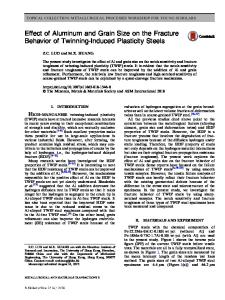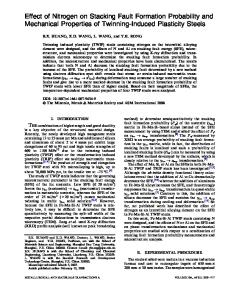Effects of Aluminum Addition on Tensile and Cup Forming Properties of Three Twinning Induced Plasticity Steels
- PDF / 2,157,971 Bytes
- 14 Pages / 593.972 x 792 pts Page_size
- 17 Downloads / 362 Views
INTRODUCTION
MANY efforts to increase fuel efficiency and to decrease CO2 emissions in automotive industries were actively conducted, and automotive steels require excellent strength to sustain automotive structures and to reduce the impact or shock in cases of accidents.[1–4] Thus, highly deformable steel plates such as transformation induced plasticity (TRIP) steels and twinning induced plasticity (TWIP) steels were actively developed.[5–17] In particular, TWIP steels were intensively studied worldwide in order to satisfy the strict requirements for automotive steels demanding high economy, environmental friendliness, and high performance. In these TWIP steels, deformation twins formed during deformation prevent the movement of dislocations as they work for the grain boundary refinement, which is known as the Hall–Petch effect,[18,19] and the necking is suppressed during deformation due to the high work hardening rate. Thus, TWIP steels show high strength and ductility simultaneously.[19–22] SEOKMIN HONG, Research Assistant, and SANG YONG SHIN, Research Assistant Professor, are with the Center for Advanced Aerospace Materials, Pohang University of Science and Technology, Pohang 790-784, Republic of Korea. Contact e-mail: neomir@postech. ac.kr HYOUNG SEOP KIM and SUNGHAK LEE, Professors, are with Center for Advanced Aerospace Materials, Pohang University of Science and Technology, and are jointly appointed with the Department of Materials Science and Engineering, Pohang University of Science and Technology. SUNG-KYU KIM, Principal Researcher, and KWANG-GEUN CHIN, Director, are with the Automotive Steels Research Group, Technical Laboratories, POSCO, Gwangyang 545-711, Republic of Korea. NACK J. KIM, Professor, is with Graduate Institute of Ferrous Technology, Pohang University of Science and Technology, is jointly appointed with the Center for Advanced Aerospace Materials, Pohang University of Science and Technology. Manuscript submitted June 16, 2011. Article published online January 31, 2012 1870—VOLUME 43A, JUNE 2012
The TWIP steels composed of austenite generally contain a considerable amount (about 20 wt pct) of Mn, because these high Mn TWIP steels have greater strength and toughness than dual-phase steels.[5,8,23–27] Despite these advantages of mechanical properties, the commercialization of high Mn TWIP steels is delayed, because the high Mn content often causes some problems such as reduced productivity due to the temperature drop of the molten steel during steelmaking, nozzle blocking during continuous casting, cracking during hot rolling, and surface oxidation of rolled products.[6,23–25] The reduction in Mn content is not easy because of the existence of stabilized austenite at room temperature and the sufficient formation of twins inside austenite grains. TWIP steels containing Al with reduced Mn content were also developed to improve formability and to prevent delayed fracture. Here, Al plays an important role in decreasing twin formation, because it works for increasing stacking fault energy (SFE).[28,29]
Data Loading...











